PAX
WFC Friendship Hour “US PAX Report (1/28)”
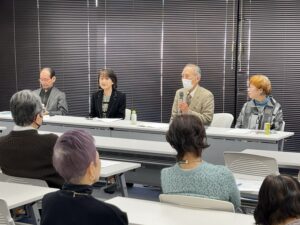 On January 28, WFC held a Friendship Hour for Okahara Tamiyuki-san, Horie Soh-san, Sunawaki Mariko-san, and Osawa Yuko-san to share about their travels to the U.S. as our PAX delegates. It was wonderful to see so many friends in attendance!
On January 28, WFC held a Friendship Hour for Okahara Tamiyuki-san, Horie Soh-san, Sunawaki Mariko-san, and Osawa Yuko-san to share about their travels to the U.S. as our PAX delegates. It was wonderful to see so many friends in attendance! 2023 Japan-U.S. PAX – application now open!
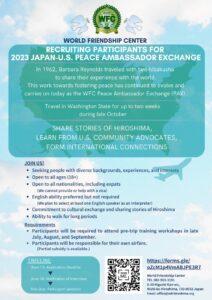 WFC has held American PAX (Peace Ambassadors Exchange) online for a couple of years due to the corona virus, but this coming fall, we will have PAX members from Japan visit the U.S. to conduct a face-to-face PAX.
WFC has held American PAX (Peace Ambassadors Exchange) online for a couple of years due to the corona virus, but this coming fall, we will have PAX members from Japan visit the U.S. to conduct a face-to-face PAX.
——–
Capacity: 4
Destination: Washington State
Dates: We are unsure of the exact dates, but it will be up to two weeks in late October.
JOIN US!
- Seeking people with diverse backgrounds, experiences, and interests
- Open to all ages (18+)
- Open to all nationalities, including expats (We cannot provide or help with a visa)
- English ability preferred but not required
(We plan to select at least one English speaker as an interpreter) - Commitment to cultural exchange and sharing stories of Hiroshima Ability to walk for long periods
Requirements
- Participants will be required to attend pre-trip training workshops in late July, August, and September.
- Participants will be responsible for their own airfare. (Partial subsidy is available.)
How to Apply & Application Deadline:
To apply for participation, please fill out this application form.
The deadline for applications is Monday, June 12.
——–
For more information, please download and review the flyer.
If you’d like to learn more about PAX, please take a look at this page for a brief introduction.
We look forward to receiving your application!
Spring 2023 US – Japan PAX
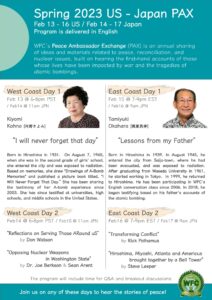 Spring 2023 US – Japan PAX
Spring 2023 US – Japan PAX
Feb 13 – 16 US / Feb 14 – 17 Japan
Program is delivered in English
WFC’s Peace Ambassador Exchange (PAX) is an annual sharing of ideas and materials related to peace, reconciliation, and nuclear issues, built on hearing the first-hand accounts of those whose lives have been impacted by war and the tragedies of atomic bombings.
Join us on any of these days to hear the stories of peace!
Spring 2023 US-Japan PAX Program
West Coast Day 1
Feb 13 @ 6-8pm PST / Feb14 @ 11am JPN
- “I will never forget that day” by Kiyomi Kohno
West Coast Day 2
Feb14 @ 6-8pm PST / Feb15 @ 11am JPN
- “Reflections on Serving Those ARound uS” by Don Watson
- “Opposing Nuclear Weapons in Washington State” by Dr. Joe Berkson & Sean Arent
East Coast Day 1
Feb 15 @ 7-9pm EST / Feb16 @ 9am JPN
- “Lessons from my Father” by Tamiyuki Okahara
East Coast Day 2
Feb16 @ 7-9pm EST / Feb17 @ 9am JPN
- “Transforming Conflict” by Rick Polhamus
- “Hiroshima, Miyoshi, Atlanta and Americus brought together by a Bell Tower” by Steve Leeper
*The program will include time for Q&A and breakout discussions.
Yu-Ai May issue 2019 — Korean PAX report by Keigo Nakamura
Yu-ai Friendship
Newsletter of the World Friendship Center, NPO
Participating in the Korean Pax
Keigo Nakamura
I learned many things and experienced many meaningful days while participating in the Korean Pax. For example, I learned about military comfort women and Korea in the Japan colonial period. I’d like to tell about four of my most impressionable experiences.
First, on the morning of the second day, I saw demonstrations held in front of a military comfort women statue near the Japanese Embassy. Many people participated in the demonstrations due to the day falling on May Day, including many students. Some, wearing yellow dresses like Jakie Chan, hit something like a sponge ball which had a face photo of Prime Minister Abe on it, which was interesting. Girl students and women with
their children also participated. I thought they were more interested in politics than Japanese people. Enjoyable activities like dances and songs were performed during demonstrations. I was surprised and interested, thinking that those looked nicer than in Japan. However, I also felt sad to see mothers participating with their small children, exposing them to Anti-Japanese sentiment at such a young age. Moreover, I had a strange feeling that I would betray my country joining this demonstration.
Second, I visited the House of Sharing. I learned about military comfort women when I visited the historical museum located on the spot where the House of Sharing was founded. I was a little bit tense because some Korean army soldiers were there. I had thought that Military Comfort Women would be all Chinese or Korean. So, I was surprised to know that
there were Japanese military comfort women too. I had an opportunity to meet former military comfort women and to hear about many things. One said to me, “I am able to forgive the present-day Japanese who were not born when I was a comfort woman. I am glad to hear your apology, but you are not responsible. My heart is not healed.” Her words impacted me deeply. She said that she wanted the Prime Minister Abe and Emperor Showa to apologize to her which made me understand what severe sufferings she had undergone.
Third, I went to Gyeongbokgung Palace. I often have seen historical Korean plays on TV, and was glad to see close-up the historical building which I saw in the TV program. I realized again that the Korean Palace was splendid. This was my second time to visit Seoul and Gyeongbokgung. I saw more black people and Westerners than the last time. I realized that Korea has become globalized.
Fourth, I experienced interaction with the host family in Korea. I was treated to Korean food – dak galbi on the second day of my visit, and to samgyupsal on the third day, as well as a Korean alcohol, mak goeli. While drinking together at that time, we talked about my grandfather and politics. Through this conversation, I learned about historical Korean plays, Korean children’s songs and the educational system of Korea. I had a friendly conversation with the host mother because both of us had something in common, learning Chinese a little. Given a lot of good sightseeing advice, I spent an enjoyable time while I was free on the fourth day.
Allow me to use this opportunity to apologize for having troubled many people when I got on the wrong train when I changed trains and got lost. I learned many things and had a valuable Golden Week. Karen invited me to participate in a summer camp in Nanjing which I’d love to do. I’d like to express my deepest gratitude to the host family in Korea, people of the Peacebuilding group that accepted the Korean PAX, and members of the WFC.
Translated by Sachiko Hiraoka
Copyright © NPO World Friendship Center 2019 All Rights Reserved
Yu-Ai May issue 2019 — Korean PAX report by Matsue Matsumoto
Yu-ai Friendship
Newsletter of the World Friendship Center, NPO
Participating in the Korean PAX
Matsue Matsumoto
I participated in the Korean PAX from April 30 to May 5. During this trip, I visited places where we usually could not go, and had very valuable experiences.
I participated in a protest meeting which was held in front of the Japanese Embassy on Wednesday May 1. The protest meeting is held on every Wednesday. In the afternoon, we went to Seodaemun Prison History Hall. On May 2, we visited the Comfort Women Historical Museum and met a Korean woman at House of Sharing. They both depicted negative legacies of the Imperial Japanese Army.
At the anti-Japan demonstration on Wednesday, a priest of the Methodist church offered his message and prayer. I couldn’t understand Korean, so I had no idea what he was saying. In the bible, Matthew 5:44 says “Love your enemies! Pray for those who persecute you!” I couldn’t understand what kind of message he offered and how he prayed for people in the demonstrations.
At the site of Seodaemun Prison History Hall, prison houses are preserved and open to the public. Activists in the independence movement were imprisoned here during the Japanese colonial period. The prison houses were also used by the Korean government after World War II. They were the buildings where tortures and death penalties were performed.
At House of Sharing, Tsukasa Yajima, a Japanese, showed us a video of the activities and protest of Ms. Kang Duk-kyung who was the first to proclaim the comfort women issue. We saw her pictures that she drew for her mental health. Each picture depicted her crying heart – a feeling I could share. After that, I met two Korean women. Their names and ages were the same. One of them looked calm as she told her story. I thought she had a strong will which would not be daunted and would persevere through anything. When I asked her “What do you want us to do? What do you want?” She answered, “Apology and compensation.” The other was a woman free from care.
On the night of the second day, I made an apology and told the A-bomb experience. During questions and answers session after my presentation, someone asked “Why don’t you ask America for an apology? You had terrible experiences due to the A-bomb.” I answered, saying “Many American people agree that the A-bomb ended the war sooner. The Japanese proverb says, ‘Leave the past in the past. Cover up what smells bad.’ Many Japanese don’t ask for apology. Some young Japanese don’t know that once Japan fought against America. Today, the power of nuclear weapons is about 4000 times as strong as that of the A-bomb dropped on Hiroshima. One bomb would contaminate half of the earth with radiation. From a humanitarian standpoint, such a powerful weapon must not be used. However, some countries possess them. I am making efforts to abolish nuclear weapons.” I don’t know whether they understood what I meant.
There is a culture of “hatred” in Korea we Japanese can’t understand. They harbor this feeling for a long period of time in their minds. However, Kim Yog-Won an author of Social Psychology (1989), points out that the Korean are very generous people and forgive others, and can accept their fate due to “hatred”. I think that both aspects are true. I can understand the Korean people seek for an apology from the top person for war responsibility. If the number of people who support the latter aspect is larger than that of the former, I think we can find a clue to reconciliation. Today, the relations between Japan and Korea are strained. I hope from now on, that young people try to solve the Japan-Korea issue.
Translated by Sachiko Hiraoka
Copyright © NPO World Friendship Center 2019 All Rights Reserved
Yu-Ai May issue 2019 — Korean PAX report by Minao Capper
Yu-ai Friendship
Newsletter of the World Friendship Center, NPO
Korea PAX
Minao Capper
On my trip to Korea though PAX I wanted to find out what the Korean youth feel about peace, understand more about the historical problems between Japan and Korea, and experience the Korean culture. I especially think I now understand the issue about the Korean women forced to be sex slaves by the Japanese military, and I could see it from a different perspective than before.
On the first day, we joined a protest in front of the Japanese embassy. I was surprised that there were many young people, even though it was a national holiday. They were very different from the Japanese students who just sit there quietly because they were told to, but instead they were actively chanting and singing songs. The young people taking it upon themselves to act on what they think is really impressive and inspired me a lot.
On the second day we went to the house of sharing and learned about the horrific things that the Japanese military made these women do in wartime.
When we heard from the Harumonis it made me think that the terrible things that we saw in the museum had happened to these women sitting in front of me.
That thought made me tear up. Going to a Japanese school and studying the Japanese peace education all my life, learning about the truth for the Koreans hurt my heart. All the Harumonis want is a formal apology and for the stories of the so called “comfort women” in the school textbooks. I can’t understand why the Japanese government can’t do that. I said this at the Q and A after Matsumoto san’s story on the third day but, I think if we don’t learn about our past mistakes, we will not be able to achieve a truly peaceful future.
During the Q and A on our third night, I got to see many different perspectives while translating, and when I was asked about what the Japanese youth think or what kind of peace education I had, I did my best to answer those questions but I felt I wasn’t answering the questions as well as I could. Not many people are as privileged as I am to be able to take part in such trips so at the very least, I want to tell my opinions and my experience in Korea to my friends and teachers in Japan.
On our final day we went shopping with my host family, Coco and Austin.
When we got back to the peace building we had diner all together then got in a circle to talk about our memories during our stay. I am so thankful for my amazing host family and all the people who made this possible. I will never forget this experience.
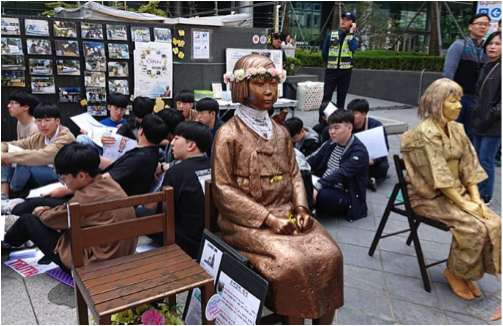
Copyright © NPO World Friendship Center 2019 All Rights Reserved
Yu-Ai May issue 2019 — Korean PAX report by Shizuo Tachibana
Yu-ai Friendship
Newsletter of the World Friendship Center, NPO
2019 Korean PAX report
Shizuo Tachibana
I visited South Korea from April 30 to May 5, 2019 as group leader of the Korean PAX tour, the Peace Ambassador Exchange. I would like to share a few thoughts regarding this Korean PAX.
We visited the House of Sharing for victims of Japanese military sexual slavery on May 2. There we met one of the grandmothers, 이옥선 Ii Ukseon, and I apologized to her as a Japanese person. However, she said that she wanted an apology from the Japanese government, not from me. She said that she didn’t expect an apology from the Prime Minister, Shinzo Abe. Hearing that for her my apology meant nothing, I was shocked. At the political level between two countries, there are so many issues going on that need to be resolved. The grandmothers have seven demands, the Japanese staff of the House of Sharing, Mr. Tsukasa Yajima told us. The Japanese government has to answer to these seven demands, which the present government chooses to ignore. Is there anything left, then, that we Japanese citizens can do for these victims of sex slavery?
On May 2, after Ms. Masue Matsumoto shared her experience of the A-bombing, there was a question to her. ‘Why don’t the Japanese ask for an apology from the U.S.?’ She explained about a characteristic attitude of Japanese people to experiences in the past. The Japanese tend to forget what happened, as one releases incidents in the stream of memory. It is not only her, but many hibakusha don’t especially want an apology from the U.S. Instead they say that they don’t want anyone to experience what they did. I know that the Japanese have to apologize and seek to be forgiven because of the war. The Korean grandmothers need an apology from the Japanese government. However, I hope that as Japanese people continue to visit the victims of the sex slavery with their apologies and a heart of love, these may heal them and they will someday accept our apologies. I believe that this is one of the things that Japanese citizen could do about the past.
In the end, I would like to express my sincere thanks to the Peace Building Community for their warm welcome and commitment to this program dedicated to peace between our countries. I hope that Korean PAX will continue to contribute to the peace of this region.
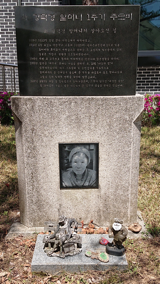
Copyright © NPO World Friendship Center 2019 All Rights Reserved
Yu-Ai November issue 2018 — USA PAX report by Mirei Tashiro
Yu-ai Friendship
Newsletter of the World Friendship Center, NPO
In retrospect of the PAX Tour USA
Foundations of Peace
The 12 day PAX Tour was, for me, an experience of many “beginnings.”
My daily experiences and realizations led to seeing Hiroshima through an outside perspective and to think of “peace” in broader ways. It also became a trip of self-discovery.
The sculpture placed at the University of Chicago where the world’s first nuclear reactor was, and the exhibit at the United States Air Force Museum both seemed to showcase the American narrative praising the achievement and development of nuclear power to this day. A statement from a Chinese man at Illinois Wesleyan pointed out the atrocities done by the Japanese imperial army to the Asian countries during WWII. Each with its own story and historical memory, how could we communicate with our eyes collectively toward the future and take steps toward peace? How should our generation pass on the history of Hiroshima?
At the Peace Conference at Illinois Wesleyan, I learned about the present state of those who need “peace” in the world due to conflicts, hate that goes back in history, income disparity, racial and sexual discrimination, etc., and of the works people are doing to better these situations. So what is “peace”? Is peace different for each individual? What are the commonalities?
These are all questions I don’t yet have clear answers for, but ones I was compelled to ask and bring home. I wish to seek answers for these questions as I gain knowledge and hopefully wisdom.
There were two things in particular I’ve noticed through our activities.
First was the several class visits we did at universities. There, we mainly spent time with questions and answers rather than a one-sided presentation. I noticed an active participation along with direct connections with the students that were very meaningful.
Second was the power of art. In my presentation I gave a brief introduction on the project, the “Grandchildren of Hiroshima.” Then there was Amano-san’s one-man drama, “Living with Father.” I realized again that art is one effective avenue that possesses an unique strength in telling the story of Hiroshima. Neither race nor nationality mattered when it came to the power that moves people and naturally leads their heart to empathize as human beings.
Above are the two points I’d like to learn from and utilize in the future. Our presentations were aimed toward university students and older this time, but I’d really like to reach a wider generation of people next time, and hopefully through many avenues including culture, history, testimonies, and art. I hope this would lead each one of us to consider nuclear issues as a humanitarian problem which we face today.
Each day was like opening up a new present. In two occasions I experienced a surprising yet a delightful reunion when a woman came up to me and told me she had known me as a baby. What I’ve realized through meeting many people and having many people take care of us is the importance of communicating, understanding, and connecting; to make a friend. I strongly felt there lies the foundation for peace.
Dan from the Brethren Volunteer Service and his wife, Wendy: Thank you for your overwhelming generosity. Through our nightly conversations, you gave me many new perspectives. Bagels, bacon, to the best coffee. You made my little American dream come true. We couldn’t have asked for a better way to begin our trip.
Josie from Illinois Wesleyan: Thank you for organizing the wonderful Peace Conference that led to so many irreplaceable connections and learning. I sensed a deep gratitude and importance of growing through learning. I loved talking with you about issues surrounding us as human beings and as women.
Tanya from Wilmington: Thank you for giving us the opportunity to experience and to ponder peace from various perspectives. I admire your quiet strength that continues to burn inside your gentleness. And thank you for all the food that were probably-the-best-ever-I’ve-had in-the-states.
Thank you also to the Snyders for helping me see the need to consider the present issues through our past history. Special thanks to the delicious homemade desserts and the extra bacon.
Alice from Bluffton: Reuniting with you after I don’t know how many years and spending your 89th birthday with you was amazing beyond words. Thank you for pouring love on me unchangingly since I was little and even now. Unsurprisingly, surrounding you was a community built on love and it felt as though I caught a glimpse of what peace needs to be founded on.
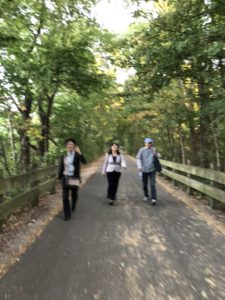
To my fellow PAX members: Thank you for every moment spent supporting each other with our quirky personalities and for all the laughter.
Lastly, I’d like to send my deepest thank you to the people at WFC who have always watched over me and for making me a part of this incredible opportunity.
Picture: I’m sorry the picture is out of focus. These are my 3 fun travel companions taking a walk and singing rather loudly into the woods!
Copyright © NPO World Friendship Center 2018 All Rights Reserved
Yu-Ai November issue 2018 — USA PAX report by Miho Nishii
Yu-ai Friendship
Newsletter of the World Friendship Center, NPO
Thinking back on the 2018 PAX Tour To America:
Peace from a True Spirit of Volunteerism
Miho Nishii
I joined PAX Tour to America from September 17th to September 28th as one of 4 PAX members. We visited 4 places: Elgin and Bloomington – Normal in Illinois; Wilmington and Bluffton in Ohio, to make presentations about peace.
The experiences of having met a lot of people with volunteer spirits in America changed my understanding of volunteerism . I learned that family units in America are open to society and people naturally work for the community as volunteers. It seemed that volunteering work are not hard obligations but delightful opportunities for each of volunteers to help people with needs. They seemingly valued individuality.
I was invited to make my presentations, including short self-introductions, at least 12 times in all during the tour. Although I was not sure if I could make my presentations understood because of my clumsy English, I was very impressed that the people I met in America tried to sincerely listen to and understand my presentations about peace. Thinking back on my presentations, each opportunity was so precious to me, even if I was not satisfied with my poor English.
As the length of this paper is limited, I am not able to introduce every presentation and what happened in this tour, but here I would like to write about the very impressive one, the panel at Illinois Wesleyan University on September 22nd.. It was so impressive because during that 2-hour panel I had been so nervous, had felt uneasy and had been very moved by the presentations of the other panelists. I was aware that the other panelists could speak near-native English and had been very experienced with peace issues. On the other hand, I believed that the heart of my idea about peace (the title was “the Spirit of the Memorial Cenotaph for Atomic Bomb Victims” ) was connected to theirs and those of each of the persons working for world peace.
About 30 minutes before the panel was finished , one Chinese man from the audience had very strong comment on my presentation, blaming the Japanese people for atrocities in China during WWⅡ. I apologized him for the Japan’s atrocities and explained the idea of my presentation, quoting the words of the former Hiroshima Mayer Shinzo Hamai: “There is no winner and no loser in a war. The cenotaph exists for mourning the dead and taking an oath not to bring about wars”.
I don’t know if my response was persuasive to him and I also hope my response was understood by the audience. I remember the moment when I was relieved to hear the clapping of hands from the audience.
I appreciate all the people who were involved in organizing this PAX tour and those who hosted us PAX members for giving us this precious opportunity.
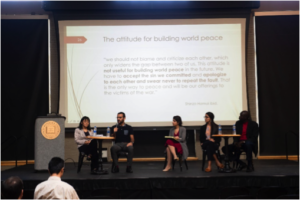
Copyright © NPO World Friendship Center 2018 All Rights Reserved
Yu-Ai November issue 2018 — USA PAX report by Tatsushi Amano
Yu-ai Friendship
Newsletter of the World Friendship Center, NPO
American PAX 2018
Tatsushi Amano
I had a chance to participate in the PAX-USA 2018.
It all started last April when Yamane-san, the WFC chairperson, asked me if I would like to perform the one-man play, “Living with Father”, in the U.S.A. I had already performed the play with English subtitles before the WFC members, including the co-directors. I agreed to the proposal with pleasure. It would be a precious chance for me to perform the play about the A-bomb on Hiroshima written by Hisashi Inoue, a prominent Japanese playwright. I was nervous because I had no confidence in my English, but thanks to the strong support of the other PAX members (Mimura-san, Nishi-san and Tashiro-san), each of my performances at four places ended in great success. I am really grateful to each person who gave me a helping hand.
During the tour, everywhere we went, the local people gave us a warm welcome. A lot of people helped us out. Before the performance at the Church of the Brethren in Elgin, Illinois on September 19, Dan was busy setting up the equipment to the last minute. On September 20, at Illinois Wesleyan University in Bloomington, Josie was a key person and a college professor there worked as my translator. The theater was filled with laughter and tears, and they gave me a standing ovation. While there, Raymond G. Wilson and his wife Akiko gave us three panoramic photos of Hiroshima after the A-bomb, which we, in turn, later passed on to Dayton International Peace Museum, Alice Ramseyer, and the WFC. Tanya of Peace Resource Center kindly climbed up a ladder for us to set up the lighting equipment at Wilmington College in Ohio on September 25. Our host family, Christine and Gene Snyder and a large number of local people and college students came over to see the play. On September 29, there were many local people at the First Mennonite Church in Bluffton, too. Barb’s brother Ken was there. Alice, who celebrated her 89th birthday, was there and vigorously took care of us.
Looking back on this PAX tour, I must give my thanks to all the people I met who guided us, who let me stay at their home, who came to see my play, and to each fellow PAX member. I must thank the people of the WFC who gave me this precious opportunity. Thank you.
I will make use of my experience of this tour to tell the message for peace through my future performances. I aim to learn more about what happened in Hiroshima and Nagasaki after the A-bombing, and how people, such as WFC founder Barbara, have endeavored to abolish nuclear weapons for world peace. I will try to pass on this history to the new generation. In this, I look forward to your assistance. Again, thank you very much.
Copyright © NPO World Friendship Center 2018 All Rights Reserved